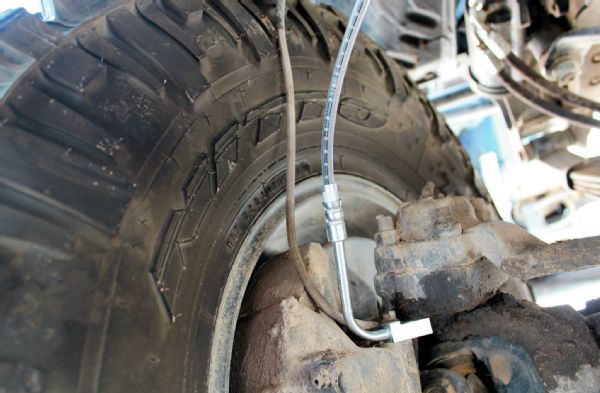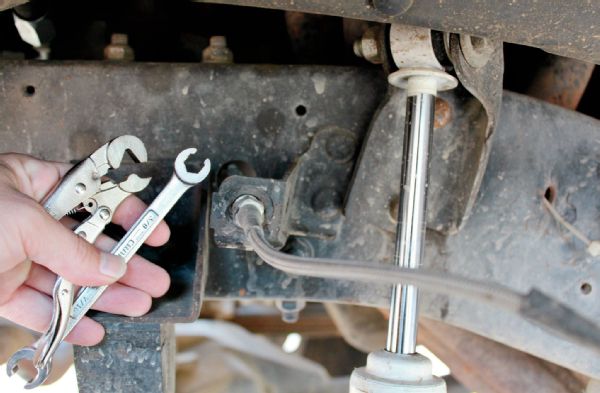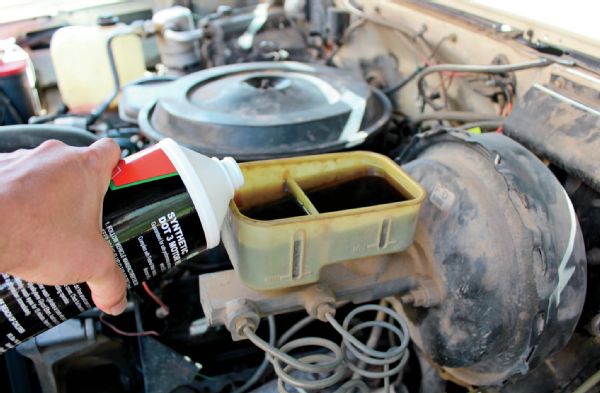
Brake lines are among the most commonly overlooked items when people install a lift kit. Because a lift kit increases the distance between a vehicle’s axles and the frame, the brake lines need to be lengthened to match the longer distance often the increased suspension travel. Yet an alarming number of lift kits don’t include brake line modifications, or they sometimes include cheesy relocation brackets that require mangling the hard lines on the frame. We’ve seen more than one vehicle roll over on the trail due to a brake line failure that could have been easily avoided if someone had spent a little extra time, energy, and money to make sure the brake hoses work properly with the suspension modifications.
Our new-to-us Blazer was typical of what we see: universal-type braided steel brake hoses without the proper leaders or DOT numbers on the front, and a worn-out stock rubber hose for the back that was too short. Knowing our brake hose situation was a disaster waiting to happen, we turned to Classic Tube for the solution. The company’s StopFlex hoses are available for an amazing number of applications, and they can be ordered in custom lengths. One call had brake hoses on the way that are DOT-approved and an exact match for the factory hoses, just with some extra length to work with our 6-inch lift kit. At less than $200 for the set, they were cheap insurance against potentially disastrous brake line failure.

Classic Tube is known for making quality prebent stainless or OE metal brake and fuel lines for everything from classic cars to modern-day trucks and SUVs. The company also manufactures StopFlex braided stainless steel brake lines that are D.O.T. certified, which means they meet or exceed OE specifications. These high-quality lines are an exact match for the factory hoses and are available in extended lengths upon request. Our new front and rear brake hoses showed up about a week after we called, and we were impressed with their sturdy construction. The hoses came with new copper crush washers, which is pretty standard, and new frame retaining clips, which are not. We appreciated that everything we needed was included, including new clips.

The front hoses on our Blazer were typical cheap universal braided stainless steel aftermarket hoses. While they were long enough to work with our 6-inch lift, they lacked a proper metal leader that would ensure that the flexible hose stays away from the tire, sway bar, bumpstop, or any other suspension part that could possibly cause it to get tangled up and snap. The StopFlex hoses include a leader to ensure that the flexible hose stays out of trouble. If you’ve done an axle swap, you need to make sure you let Classic Tube know the source of the calipers used on the donor so that you can be sure the hoses have the proper banjo bolt hole and brake leader arrangement.

Always use a line wrench when tightening or loosening the hard lines on the frame, as the fittings are easy to round off with a regular wrench. If that has already happened, as it had in our case due to the previous owner, then we’ve found that these tiny locking pliers with specially formed jaws for biting stripped-out fittings are the perfect solution. They get the fittings loosened and tightened without further mangling the fittings. If your hard lines are rusted out or damaged, Classic Tube offers prebent replacements for most applications, which work great.

When you finish swapping the brake hoses, you will need to bleed the entire brake system. Follow the instructions in the factory service manual. Start with the brake farthest from the master cylinder (passenger rear), and work your way to the closest. Sometimes you can get lucky and the system will gravity-bleed, but most of the time you’ll need the help of an assistant to pump the brakes. Keep the master cylinder topped off while bleeding; you’ll have to start all over again if you let it go dry.